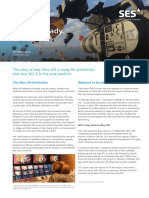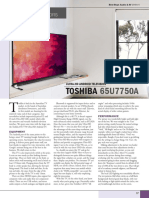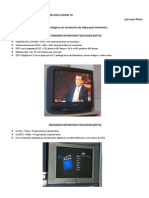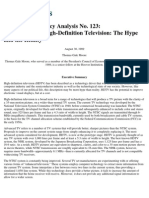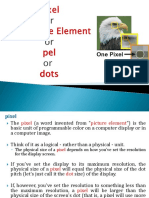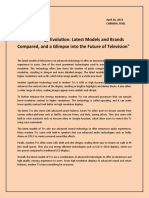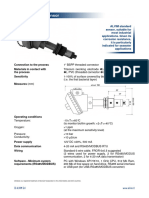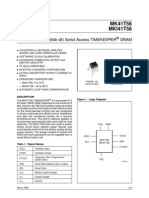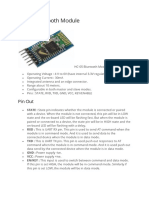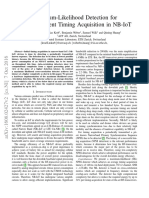0 ratings0% found this document useful (0 votes)
30 viewsFeature Uhdtv
Feature Uhdtv
Uploaded by
Alexander WieseUltra High Definition Television (UHDTV) has significantly higher resolution than HDTV, with 4K UHDTV having 4 times and 8K UHDTV having 16 times the resolution of HDTV. UHDTV also provides wider color gamut and higher frame rates up to 120 frames per second to improve 3D video quality. However, UHDTV requires much greater bandwidth for transmission and new equipment that is not backward compatible with existing HDTV systems. While the technology and standards are still in development, UHDTV is expected to eventually become widely available despite current limitations.
Copyright:
Attribution Non-Commercial (BY-NC)
Available Formats
Download as PDF, TXT or read online from Scribd
Feature Uhdtv
Feature Uhdtv
Uploaded by
Alexander Wiese0 ratings0% found this document useful (0 votes)
30 views2 pagesUltra High Definition Television (UHDTV) has significantly higher resolution than HDTV, with 4K UHDTV having 4 times and 8K UHDTV having 16 times the resolution of HDTV. UHDTV also provides wider color gamut and higher frame rates up to 120 frames per second to improve 3D video quality. However, UHDTV requires much greater bandwidth for transmission and new equipment that is not backward compatible with existing HDTV systems. While the technology and standards are still in development, UHDTV is expected to eventually become widely available despite current limitations.
Copyright
© Attribution Non-Commercial (BY-NC)
Available Formats
PDF, TXT or read online from Scribd
Share this document
Did you find this document useful?
Is this content inappropriate?
Ultra High Definition Television (UHDTV) has significantly higher resolution than HDTV, with 4K UHDTV having 4 times and 8K UHDTV having 16 times the resolution of HDTV. UHDTV also provides wider color gamut and higher frame rates up to 120 frames per second to improve 3D video quality. However, UHDTV requires much greater bandwidth for transmission and new equipment that is not backward compatible with existing HDTV systems. While the technology and standards are still in development, UHDTV is expected to eventually become widely available despite current limitations.
Copyright:
Attribution Non-Commercial (BY-NC)
Available Formats
Download as PDF, TXT or read online from Scribd
Download as pdf or txt
0 ratings0% found this document useful (0 votes)
30 views2 pagesFeature Uhdtv
Feature Uhdtv
Uploaded by
Alexander WieseUltra High Definition Television (UHDTV) has significantly higher resolution than HDTV, with 4K UHDTV having 4 times and 8K UHDTV having 16 times the resolution of HDTV. UHDTV also provides wider color gamut and higher frame rates up to 120 frames per second to improve 3D video quality. However, UHDTV requires much greater bandwidth for transmission and new equipment that is not backward compatible with existing HDTV systems. While the technology and standards are still in development, UHDTV is expected to eventually become widely available despite current limitations.
Copyright:
Attribution Non-Commercial (BY-NC)
Available Formats
Download as PDF, TXT or read online from Scribd
Download as pdf or txt
You are on page 1of 2
FEATURE
Ultra High Definition Television
kunnen kleuren, vooral rood en groen tinten beter weer te geven geschikt voor 3D vanwege de hogere framesnelheid vraagt een enorme bandbreedte gebruikers zullen gloednieuwe apparatuur nodig zoals UHDTV is niet achterwaarts compatibel
162 TELE-audiovision International The Worlds Largest Digital TV Trade Magazine 09-10/2013 www.TELE-audiovision.com
www.TELE-audiovision.com 09-10/2013 TELE-audiovision International
163
FEATURE
Ultra High Definition Television
Whats behind the new standard? Is it even a standard?
Jacek Pawlowski
We all are familair with High Definition Television. HDTV uses picture resolutions of either 720p, 1080i or 1080p. The first two are used for broadcasting TV via satellites while the last one is mostly used with Blu-ray discs. A HDTV video signal has either 50 or 60 picture frames per second. If a complete picture is sent in every frame, the letter p is added after the resolution figure (720p or 1080p). If only half the horizontal lines are sent in one frame (only odd number lines, then only even number lines and so on), the letter i depicts such interlaced video. Most of the contemporary satellite TV receivers upscale any 720p or 1080i video signals to 1080p and then output the video to your living room TV. Now, if we focus on the best version of HDTV 1080p it has a picture resolution of 1920 x 1080. The new 4K UHDTV standard has doubled the resolution in both axes to 3840 2160 while the 8K UHDTV has even quadrupled it: 7680 4320. The best way to realize how big an improvement UHDTV introduces is to look at our simple picture showing TV screens for different standards but the same pixel size (see picture). Imagine this: 4K is like arranging 4 HD TV-sets in a 2x2 array, while for 8K UHDTV one would need 8 HD TVs arranged in a 4x4 array! Though resolution is the most obvious improvement over classical HDTV it is by no means the only parameter that has been changed. The other two related to video are: color space and frame rate. UHDTV has a wider color space than HDTV. In particular, UHDTV picture is able to reproduce more deeply red and more deeply green colors which can not be shown by our existing HDTV equipment. In this way, UHDTV is able to reproduce more natural colors. The standard extends the allowable frame rates up to 120 frames per second. In this way 3D video can be reproduced with up to 60 fps for each eye. 60 fps are typical for North American TV whilst 50
Comparison of the TV screens for different resolution standards.
fps is used in most other areas including Europe. Therefore European 3D TV will use 100 fps rather than 120 fps. Adding to these enormous improvements in video performance, UHDTV also expanded the audio quality. With the new UHDTV standard an astounding 22 audio channels plus 2 low frequency effects channels are possible. The 22 channels are divided into three groups: an upper layer of nine channels, a middle layer of ten channels and a lower layer of three channels. Such complex audio setups can be found at movie theatres and thus with UHDTV this also becomes available to the average viewer. Of course, the first thing in order to enjoy that big resolution is a UHDTV compliant TV monitor. The best TV manufacturers already offer 4K UHDTV TV-sets with large screen (70 or more). Monitors capable of showing 8K can be seen at the professional broadcasting exhibitions but sofar we know of no such monitor available at regular stores. Now, what about the sources of ultra HD video? Presently, the choice is extremely small. One model of UHDTV video player has been announced with a few pre-stored movies in 4K format on the internal HDD. Blu-ray Disc Association have just started their work on extending Blu-Ray Disc specification to include 4K Ultra HD video. Similarly, Sony announced that their PlayStation 4 will support 4K resolution but only for photos and videos not for the games themselves. And what is going on in the satellite industry? In Europe EUTELSAT has started 4K UHD test transmissions coded with the MPEG-4 codec on EUTELSAT 10A. Quite recently, SES has done one step further and started a 4K channel coded with the newest HEVC (H.265) codec that helped reducing the necessary bitrate down to 20 Mbit/sec. You do not have to be an expert to realize that 4K UHDTV requires 4 times more bits than HDTV and 8K UHDTVrequires 16 times more bits. This is really a problem because the communication networks have finite throughput rates. HEVC, known also as H.265, can help here as its efficiency is roughly 2 times better than MPEG 4. But even using the best available codec you still need about 20 Mbit/sec for 4K UHDTV and as much as 80 Mbits/sec to broadcast a single channel. And all this for 50/60 fps. If you liked to double the frame rate to 100/120 to transmit 3D UHDTV you would need twice the bandwidth. It is funny to think that if in the future 8K is introduced to satellite broadcast, one transponder will be carrying a maximum one channel like in the old days of analog TV. The list of devices and standards that still have to be developed or extended is long: UHDTV cameras and other studio equipment, HDMI interface, audio equipment, and, of course, all kinds of digital TV receivers: satellite, cable, IPTV and (maybe) terrestrial. New equipment will require new chip-sets and perhaps even new hardware architecture to do the job efficiently. UHDTV is not backward compatible with HDTV. In other words, your present HDTV receiver will not process a UHDTV channel. Naturally, in the beginning, there will be a scarcity of ultra high resolution programs and many UHDTV channels will be created by up-scaling regular HDTV. We can still remember the first years of HDTV or more recently 3D HDTV the same will happen with UHDTV. However, despite all the technology, communication and media problems linked with UHDTV, we strongly believe that the race has started for good and sooner or later we will all enjoy the wonderful ultra high definition pictures in our houses.
164 TELE-audiovision International The Worlds Largest Digital TV Trade Magazine 09-10/2013 www.TELE-audiovision.com
You might also like
- Electronic Weighing Scale Circuit Diagram PDFDocument4 pagesElectronic Weighing Scale Circuit Diagram PDFAbhay Mishra100% (1)
- History of ComputerDocument7 pagesHistory of ComputerAila Janella ValdezNo ratings yet
- DFTC1 2007.12 StudentGuideDocument624 pagesDFTC1 2007.12 StudentGuideThi Nguyen100% (1)
- XCAP-LTE Analyzer LTE Parameter AccuverDocument98 pagesXCAP-LTE Analyzer LTE Parameter Accuvericq201950% (2)
- Cushman 303 O&M ManualDocument20 pagesCushman 303 O&M Manual240GL guyNo ratings yet
- Feature UhdtvDocument2 pagesFeature UhdtvAlexander WieseNo ratings yet
- Feature UhdtvDocument2 pagesFeature UhdtvAlexander WieseNo ratings yet
- Feature UhdtvDocument2 pagesFeature UhdtvAlexander WieseNo ratings yet
- Feature UhdtvDocument2 pagesFeature UhdtvtelesatelliteporNo ratings yet
- Feature UhdtvDocument2 pagesFeature UhdtvAlexander WieseNo ratings yet
- Feature UhdtvDocument2 pagesFeature UhdtvAlexander WieseNo ratings yet
- Feature UhdtvDocument2 pagesFeature UhdtvAlexander WieseNo ratings yet
- Feature UhdtvDocument2 pagesFeature UhdtvAlexander WieseNo ratings yet
- Feature UhdtvDocument2 pagesFeature UhdtvAlexander WieseNo ratings yet
- Feature UhdtvDocument2 pagesFeature UhdtvAlexander WieseNo ratings yet
- Feature UhdtvDocument2 pagesFeature UhdtvAlexander WieseNo ratings yet
- Feature UhdtvDocument2 pagesFeature UhdtvAlexander WieseNo ratings yet
- Feature UhdtvDocument2 pagesFeature UhdtvAlexander WieseNo ratings yet
- Ultra HD Via Satellite: Key Features of The New Demonstration Channel ON HOT BIRD (13° East)Document2 pagesUltra HD Via Satellite: Key Features of The New Demonstration Channel ON HOT BIRD (13° East)Florin NicolaNo ratings yet
- 4K Resolution: The Future of ResolutionsDocument15 pages4K Resolution: The Future of ResolutionsRavi JoshiNo ratings yet
- Ultra HDDocument4 pagesUltra HDJanna WilsonNo ratings yet
- Questions & AnswersDocument3 pagesQuestions & AnswersJaimichu07No ratings yet
- HD & HDTV: PAL NTSC 576i (Digital PAL) 480i (Digital NTSC) S Resolution Frame Rate Aspect RatiosDocument9 pagesHD & HDTV: PAL NTSC 576i (Digital PAL) 480i (Digital NTSC) S Resolution Frame Rate Aspect Ratioscr0zzb0wNo ratings yet
- High Definition TelevisionDocument40 pagesHigh Definition TelevisionMousum Dutta100% (1)
- HDTVDocument22 pagesHDTVkprk414No ratings yet
- Alem Do HDTVDocument22 pagesAlem Do HDTVFabio ArpNo ratings yet
- Beginning With IPBox 9xxxHD 120609 enDocument56 pagesBeginning With IPBox 9xxxHD 120609 enArnold StirlitzNo ratings yet
- GR HK 2007 IntDocument39 pagesGR HK 2007 IntpokornypvlNo ratings yet
- SES Ultra HD 4KDocument8 pagesSES Ultra HD 4KJaimichu07No ratings yet
- 4k - Consumer-Whitepaper FINAL (As)Document6 pages4k - Consumer-Whitepaper FINAL (As)jcmendez506No ratings yet
- Toshiba Guía U77Document2 pagesToshiba Guía U77Lopez OmarNo ratings yet
- Delivering Quality Ultra HDDocument12 pagesDelivering Quality Ultra HDEdward CallowNo ratings yet
- High Definition VideoDocument1 pageHigh Definition VideorocountNo ratings yet
- 55pus6262_12_pss_Document3 pages55pus6262_12_pss_Nico RossiNo ratings yet
- HDTVDocument2 pagesHDTVRegine Kaye TagurdaNo ratings yet
- SLIDEDocument15 pagesSLIDEPritesh SapariaNo ratings yet
- DigitaltvamitDocument15 pagesDigitaltvamita_mitNo ratings yet
- The New HEVC/H.265 Standard: FEATURE Ultra High DefinitionDocument2 pagesThe New HEVC/H.265 Standard: FEATURE Ultra High DefinitionAlexander WieseNo ratings yet
- Beginners Guide For 9xxxHD Series 231208 enDocument37 pagesBeginners Guide For 9xxxHD Series 231208 enelgeneral-forokeys7539100% (5)
- First-Class in Every Sense.: Sound & Vision 2011 - 2012Document27 pagesFirst-Class in Every Sense.: Sound & Vision 2011 - 2012Razvan BaraganNo ratings yet
- HD TV Made Easy WorkshopDocument47 pagesHD TV Made Easy WorkshopJohnNo ratings yet
- De La Standard TV A La Nueva Super High Vision TVDocument17 pagesDe La Standard TV A La Nueva Super High Vision TVJuan PerezNo ratings yet
- Test 3 SkjaDocument4 pagesTest 3 Skjasalva15regNo ratings yet
- PVI VeCoax HDMI To QAM HD Modulator With IPTV Stream SpecificationsDocument6 pagesPVI VeCoax HDMI To QAM HD Modulator With IPTV Stream SpecificationsDavid WardNo ratings yet
- High Definition TV: Audio-Video SystemsDocument4 pagesHigh Definition TV: Audio-Video SystemsAtit PatelNo ratings yet
- The Road To UHDTV: in 2020 Everyone Will Have It Until Then, There's Much Work To DoDocument12 pagesThe Road To UHDTV: in 2020 Everyone Will Have It Until Then, There's Much Work To DoPedro Antonio González EspinozaNo ratings yet
- Ultra-High-Definition TelevisionDocument11 pagesUltra-High-Definition TelevisionYiddam QuiriarteNo ratings yet
- Philips 40pfl3706 40pfl3706 f7 Manual de UsuarioDocument3 pagesPhilips 40pfl3706 40pfl3706 f7 Manual de UsuarioAbelardoNo ratings yet
- TV Broadcasting Part 2Document61 pagesTV Broadcasting Part 2Mikaela Dela CruzNo ratings yet
- The Promise of High-Definition Television: The Hype and The Reality, Cato Policy AnalysisDocument9 pagesThe Promise of High-Definition Television: The Hype and The Reality, Cato Policy AnalysisCato InstituteNo ratings yet
- 01 01 PixelDocument18 pages01 01 PixelBINJADNo ratings yet
- Emerging Technologies in BroadcastingDocument44 pagesEmerging Technologies in BroadcastingYashank JainNo ratings yet
- Ultra Slim 4K UHD LED Smart TV: With Ambilight 3-SidedDocument3 pagesUltra Slim 4K UHD LED Smart TV: With Ambilight 3-SidedMercedes Ruiz MarquezNo ratings yet
- Beyond HDTV Technology: Srećko Kunić, Zoran ŠegoDocument5 pagesBeyond HDTV Technology: Srećko Kunić, Zoran ŠegoAntonioCastilloNo ratings yet
- TV Technology Evolution Latest Models and Brands Compared, and A Glimpse Into The Future of TelevisionDocument4 pagesTV Technology Evolution Latest Models and Brands Compared, and A Glimpse Into The Future of TelevisionYouNo ratings yet
- Camarig, Kinjie D. Btled Iii-1 Learning Assessment 1. Name Analog Video FormatsDocument3 pagesCamarig, Kinjie D. Btled Iii-1 Learning Assessment 1. Name Analog Video FormatsKIN JIENo ratings yet
- HDTV T: EchnologyDocument26 pagesHDTV T: EchnologyDivya KrishnanNo ratings yet
- High Definition TelevisionDocument11 pagesHigh Definition TelevisionNitin PanchalNo ratings yet
- White Paper - Extron - 4kuhd DistributionDocument10 pagesWhite Paper - Extron - 4kuhd Distributionmkthakur6410No ratings yet
- Nick Davies 21 1Document11 pagesNick Davies 21 1api-337613910No ratings yet
- Colour Banding: Exploring the Depths of Computer Vision: Unraveling the Mystery of Colour BandingFrom EverandColour Banding: Exploring the Depths of Computer Vision: Unraveling the Mystery of Colour BandingNo ratings yet
- How to Get Rid of Cable TV & Save Money: Watch Digital TV & Live Stream Online MediaFrom EverandHow to Get Rid of Cable TV & Save Money: Watch Digital TV & Live Stream Online MediaRating: 3.5 out of 5 stars3.5/5 (2)
- Cascadeerbare SCR Multiswitches Spaun Sus 5581/33 NF Legacy & Sus 5581 FDocument5 pagesCascadeerbare SCR Multiswitches Spaun Sus 5581/33 NF Legacy & Sus 5581 FAlexander WieseNo ratings yet
- Speedcast: Satelliet Uplink Speedcast, Barueri, SP, Brazilië BedrijfsrapportDocument8 pagesSpeedcast: Satelliet Uplink Speedcast, Barueri, SP, Brazilië BedrijfsrapportAlexander WieseNo ratings yet
- OreindDocument4 pagesOreindAlexander WieseNo ratings yet
- Mktech Is1-19Hd & Ontvanger: Satelliet en Terrestriële PVR Ontvanger TestrapportDocument7 pagesMktech Is1-19Hd & Ontvanger: Satelliet en Terrestriële PVR Ontvanger TestrapportAlexander WieseNo ratings yet
- Horizon HD-CM+ Voor: DVB-C Signaalmeter TestrapportDocument5 pagesHorizon HD-CM+ Voor: DVB-C Signaalmeter TestrapportAlexander WieseNo ratings yet
- Dragonsat Ds-5500Hd: HDTV Satellietontvanger TestrapportDocument8 pagesDragonsat Ds-5500Hd: HDTV Satellietontvanger TestrapportAlexander WieseNo ratings yet
- Feature Satip3Document7 pagesFeature Satip3Alexander WieseNo ratings yet
- Deviser TV Analyser s7000: Deel 1: Analyzer FunctionsDocument15 pagesDeviser TV Analyser s7000: Deel 1: Analyzer FunctionsAlexander WieseNo ratings yet
- WsinternationalDocument1 pageWsinternationalAlexander WieseNo ratings yet
- Au DoliciDocument7 pagesAu DoliciAlexander WieseNo ratings yet
- Changhong Helpt Slachtof-Fers Van Een: NoodhulpDocument3 pagesChanghong Helpt Slachtof-Fers Van Een: NoodhulpAlexander WieseNo ratings yet
- IcecryptDocument1 pageIcecryptAlexander WieseNo ratings yet
- JiuzhouDocument1 pageJiuzhouAlexander WieseNo ratings yet
- 8 DtekDocument1 page8 DtekAlexander WieseNo ratings yet
- IpontDocument1 pageIpontAlexander WieseNo ratings yet
- Ab 3 DboxDocument1 pageAb 3 DboxAlexander WieseNo ratings yet
- Company ReportDocument8 pagesCompany ReportAlexander WieseNo ratings yet
- IGBT Plasma Panasonic Placa Ysus IRG4BC40UDocument8 pagesIGBT Plasma Panasonic Placa Ysus IRG4BC40UAntonio ChavezNo ratings yet
- Time Lag SwitchDocument2 pagesTime Lag SwitchSravan SimhadriNo ratings yet
- CX - JN3Document74 pagesCX - JN3Jarvin Saenz PavónNo ratings yet
- PAVIRO Installation Manual enUS 18014418492744331Document30 pagesPAVIRO Installation Manual enUS 18014418492744331Jekonia JakobNo ratings yet
- Altera DSP Builder Handbook Vol 1 - Intro Do DSP BuilderDocument790 pagesAltera DSP Builder Handbook Vol 1 - Intro Do DSP BuilderrastaforteNo ratings yet
- MRU3-1 - AC Voltage Relay: Manual MRU3-1 (Revision A)Document38 pagesMRU3-1 - AC Voltage Relay: Manual MRU3-1 (Revision A)Eduardo JoseNo ratings yet
- BTS 3102Document5 pagesBTS 3102Allan AzucenaNo ratings yet
- Basic Layout of OLTDocument3 pagesBasic Layout of OLTgulasbotNo ratings yet
- SM 41Document63 pagesSM 41Lucas VidoNo ratings yet
- Ats1170 MainstDocument2 pagesAts1170 Mainstdanut.helinickNo ratings yet
- Electromagnetic Radiation Due To Cellular, Wi-Fi and Bluetooth Technologies: How Safe Are We?Document22 pagesElectromagnetic Radiation Due To Cellular, Wi-Fi and Bluetooth Technologies: How Safe Are We?ddNo ratings yet
- ALVIM A001S3 DatasheetDocument1 pageALVIM A001S3 DatasheetAlgirdas BaranauskasNo ratings yet
- M.Tech. PE III SemDocument2 pagesM.Tech. PE III SemDrMohammad Rafee ShaikNo ratings yet
- LTE Critical AlarmsDocument3 pagesLTE Critical AlarmsHassanwateen0% (1)
- Water Level Controller Using Microcontroller and BuzzerDocument65 pagesWater Level Controller Using Microcontroller and Buzzermohit73% (11)
- MK41T56 MKI41T56: 512 Bit (64b x8) Serial Access TIMEKEEPER SramDocument16 pagesMK41T56 MKI41T56: 512 Bit (64b x8) Serial Access TIMEKEEPER SramzdravkorrNo ratings yet
- Word Recognition Device: C.K. Liang & Oliver Tsai ECE 345 Final Project TA: Inseop Lee Project Number: 22Document21 pagesWord Recognition Device: C.K. Liang & Oliver Tsai ECE 345 Final Project TA: Inseop Lee Project Number: 22Bruno Garcia TejadaNo ratings yet
- Introduction To Computing: Polytechnic University of The Philippines Lopez BranchDocument9 pagesIntroduction To Computing: Polytechnic University of The Philippines Lopez BranchDon OleaNo ratings yet
- HC-05 Bluetooth Module: Pin OutDocument3 pagesHC-05 Bluetooth Module: Pin OutlakshmiNo ratings yet
- NB IoT NPSS NSSS Acquisition ETHgroup PDFDocument5 pagesNB IoT NPSS NSSS Acquisition ETHgroup PDFMiloš Milaković100% (1)
- 33-Design of Scalable Memory Using RAM's - ROM's Chips - Construction of Larger Size Memories-16-03-2024Document32 pages33-Design of Scalable Memory Using RAM's - ROM's Chips - Construction of Larger Size Memories-16-03-2024KBS SrikarNo ratings yet
- Microsonic MIC 130 IU TCDocument2 pagesMicrosonic MIC 130 IU TCbudi santosoNo ratings yet
- True Power - Servo StabilizerDocument2 pagesTrue Power - Servo StabilizerKrishan singhNo ratings yet
- 4CAE000907 TRO620 Data SheetDocument5 pages4CAE000907 TRO620 Data SheetMohammed MostefaiNo ratings yet
- CB12245A DIN Rail Mount Battery Charger 12V 24V DatasheetDocument1 pageCB12245A DIN Rail Mount Battery Charger 12V 24V DatasheetGeoff CNo ratings yet




























